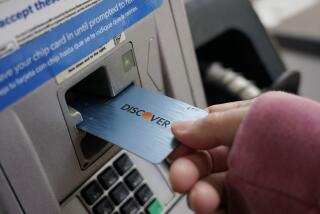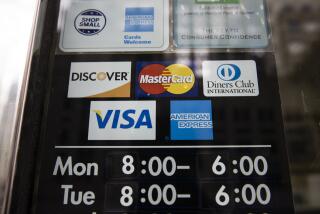Banks Expected to Help Lift Economy
After the terrorist attacks, many banks moved quickly to help customers by forgiving missed payments on loans, covering overdrafts and payrolls and providing quick access to large sums of cash.
But the bigger question now is how U.S. banks respond to calls by the Federal Reserve and others to do more than just bandage the economic wounds.
The Fed has poured billions of dollars into the banking system to boost short-term lending and has lowered interest rates beyond expectations, sending bankers a clear signal to help keep the economy from collapsing.
“I’ve never seen anything like it,” said American Bankers Assn. senior economist Rod Strand.
Unlike the early 1990s, when the banking system was ill-equipped to help fend off an economic recession, the industry is on stable ground.
Capital reserves are high and loan defaults are at relatively low levels--all of which is expected to help banks come to the aid of hard-hit borrowers.
But there also are some ominous signs, in particular the high debt loads of many consumers and companies. That might dampen banks’ lending urge. Still, it’s clear that regulators are counting on financial institutions to help lead the country through the slowdown and the recovery from the terrorist attacks.
The Fed said banks would “promote the public interest” by forgiving late fees caused by the attacks, giving sound borrowers more time to pay and easing paperwork for new loans.
On Monday, the Department of Housing and Urban Development invoked a 1940 federal act reducing interest rates on mortgages and personal loans to 6% and halting or limiting foreclosures and evictions for military reservists and members of the National Guard called to active duty.
The Soldiers’ and Sailors’ Relief Act, which last was used during the Persian Gulf War in 1991, is aimed at helping to offset financial hardships suffered by those called to military duty.
Two days after the strikes at the World Trade Center and the Pentagon, Michael J. Zamorski, acting director of supervision at the Federal Deposit Insurance Corp., told bank examiners in a memo not to criticize lenders for taking on greater risks to help customers recover from the disaster and its aftermath.
Even so, the banks face a dilemma like that posed by earthquake, flood and hurricane damage: how to sympathetically nurse good companies back to health without triggering a surge in defaults by lending to those beyond recovery.
“The trick is to determine which companies in the industry are going to survive and eventually get back on their feet and therefore deserve the support, versus those which already may have been on the cusp and may not be going to make it anyway,” said Richard C. Kovacevich, chairman of Wells Fargo & Co.
Bank of America Corp. loan officers, who have been calling customers since the attacks to inquire about any problems, already have had many reports of declining revenue, said Rod Banks, BofA’s head of commercial lending in California.
“If the problem is directly related to what happened on Sept. 11, we’ll accommodate them” by deferring payments or restructuring loans, Banks said.
Even while banks continue to lend under stressful conditions, they “also have a responsibility to be in business for a long time, not to be a junior Federal Reserve,” said banking consultant Alex Sheshunoff in Austin, Texas. “At the end of the day, they still have to deal with the loans they make.”
The last time America was at war, after Iraq’s 1990 invasion of Kuwait helped topple the United States into recession, major banks were recovering from devastating losses on loans to less developed countries, and more losses loomed on real estate loans and corporate takeover loans. Also, rising competition was squeezing profits at smaller banks.
The savings and loan fiasco, created partly by laws allowing thrifts to make risky investments with federally insured deposits, had left that industry near death and taxpayers with billions in debts to cover S&L; losses.
“Banks were limping into the last recession, and thrifts were on life support,” recalled David Barr, a spokesman for the FDIC.
Barr and others noted that new laws and heavier scrutiny a decade ago also helped foster overly cautious lending--a credit crunch that exacerbated the recession then.
The industry is in much better financial shape now. At the end of June, for example, the FDIC had only 80 banks on its “problem” list, compared with more than 1,600 in 1990.
While banks’ total assets rose 84% from 1990 to 2000, totaling $6.24 trillion at year’s end, the industry’s net income rocketed 345% in the same period. Banks earned $71.1 billion last year. Soaring income has allowed the banks to build up their equity capital, which is the industry’s cushion against financial trouble.
Still, troubled loans have been rising. “Noncurrent” loans--those past due 90 days or more--stood at $48.8 billion at the end of June, up from $42.9 billion at the end of 2000 and up sharply from $31 billion at the end of 1998, the FDIC said.
As a percentage of total bank assets, however, noncurrent loans are at half their levels of 1990.
Banks may be especially wary of heavily indebted consumers--many of whom had helped shore up the economy until the attacks.
In the spring quarter, commercial banks wrote off $2.8 billion in uncollectable credit card debt, up 27% from a year earlier. Mortgage delinquencies in June reached their highest level since 1992, and business and consumer bankruptcies jumped 24.5% in the April-June period.
“The way it looks now, the banks are going to have more problems, and they know it,” said banking consultant Bert Ely in Alexandria, Va.
Consumers may be able to count on another lending source: companies desperate to drum up business. Ford Motor Co. and General Motors Corp. are offering qualified buyers interest-free financing for three to five years on most new cars, for example, in an effort to bolster sales and pump up overall economic activity.
In the days immediately after the attacks, banks rolled out a variety of programs to help customers. They waived late fees on mortgages, auto loans and credit card payments for a week or more because of delays in the postal system. Most mortgage lenders allowed homeowners directly affected by the attacks to skip payments for 90 days.
Wachovia Corp., the Charlotte, N.C., parent of First Union National Bank and Wachovia Bank, offered consumers affected by the attacks unsecured three-year loans of up to $15,000 at 10% interest, with no origination fee and no payments for 60 days.
On Friday, Washington Mutual Bank said customers suffering financial hardship because they lost a family member in the attacks will be allowed to defer payments on mortgages and consumer loans for as long as one year.
(BEGIN TEXT OF INFOBOX / INFOGRAPHIC)
Banks: A Healthier Picture
The nation’s commercial banks are viewed as a potential bulwark for the struggling economy because the industry is in strong financial health compared with 1990-91, the last recession. Bank earnings soared in the 1990s, boosting the industry’s equity capital--its cushion against financial trouble.
Banks’ earnings have surged . . .
Net income each year
(In billions)
*--*
1990: $16.0 1991: 17.9 1992: 32.0 1993: 43.0 1994: 44.6 1995: 48.8 1996: 52.4 1997: 59.2 1998: 61.8 1999: 71.6 2000: $71.1
*--*
. . . boosting the industry’s capital.
Equity capital at Dec. 31 each year
(In billions)
*--*
1990: $218.6 1991: 231.7 1992: 263.4 1993: 296.5 1994: 312.1 1995: 349.6 1996: 375.3 1997: 417.8 1998: 462.1 1999: 479.7 2000: $529.8
*--*
Source: Federal Deposit Insurance Corp.
*
Times staff writer John O’Dell contributed to this report.
More to Read
Inside the business of entertainment
The Wide Shot brings you news, analysis and insights on everything from streaming wars to production — and what it all means for the future.
You may occasionally receive promotional content from the Los Angeles Times.











